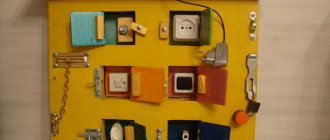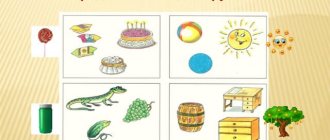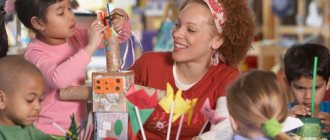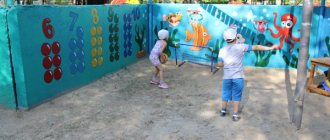Decoration of the corner “Our mood”
Organization of the corner -
“Our mood”
Teacher of senior group No. 6.
The mood corner is a means of self-knowledge and development of the child’s emotional sphere.
But there are many means of developing a person’s emotional world. Here are the simplest and most accessible ways to develop and shape a child’s emotional world.
Target:
expanding teachers’ understanding of the meaning and ways of organizing a mood corner in group rooms.
Developmental environment of preschool educational institutions
should be enriched with various elements that create in children a positive attitude and impression of the kindergarten, which will help
(tasks):
1.
Overcome the stress of admission,
2.
Successfully adapt to a preschool institution,
3
. Will contribute to the psychological and emotional health of each child’s personality,
4
. Development of the emotional and sensory sphere.
Such an environment can be called an emotionally developing environment or a mood corner.
One of the options for zoning and enriching group premises with a variety of game elements aimed at preserving the psychophysical health of preschool children, developing their emotional, sensory and communicative sphere, positive acceptance of themselves and the world around them:
1. “Welcome Corner”
Target:
promote the mental and personal growth of the child, uniting the children's team, creating a positive emotional mood, an atmosphere of group trust and acceptance; the ability to notice positive qualities in people and talk about it.
Material used:
• Stand "Hello, I'm here!"
with photos of children (when coming to the kindergarten, the child turns his photo to face those around him, i.e. declaring his presence in the group);
• Stand “My Mood”
(children use pictograms to determine their mood during the day);
• Card index of games-minutes “entering the day” (“
Compliments”, “Echo”, “Tender name”, etc.).
2. “Achievement Corner”
Target:
increase self-esteem and self-confidence of children, provide positive information for parents that helps establish mutual understanding between them;
teach children to be sensitive, respectful and friendly towards people. • “Flower of Success”/“Star of the Week”:
in the middle of the “daisy” flower there is a photo, on the petals (during the week) information is written about the child’s results for the day, which he is proud of;
• "Treasury of good deeds":
a panel with pockets for each child, where “chips” are placed for each kind and useful deed/deed (children are rewarded at the end of the week).
3. Anger Corner
Target:
provide children with the opportunity to free themselves in an acceptable form from overwhelming anger, irritation and tension.
• "Rug of Anger"
— a rubber studded mat on which children can trample;
• "Box of Anger and Irritation"
- a dark-colored box where children throw out all their “anger and resentment” (by first clenching their fists and collecting in them everything that has accumulated “bad things” or by crumpling/tearing sheets of large newspapers);
• "Pillow-beater"
bag “For shouting”, “Bridge of Friendship”, soft fabric-foam hammers, light balls (knitted pom-poms), etc.
• "Leaf of Wrath"
- a printed sheet that can be crumpled, torn, thrown, etc.
Leaf of Anger
4. “Privacy Corner”
(there should be several)
Target:
create conditions for rest, privacy for children, relaxation and independent play during the day, necessary for the expression of stressful situations experienced by children, for example, separation from parents in the morning, getting used to a new routine, etc.
• A soft sofa, comfortable armchairs, a translucent screen;
• Mobile “Transforming House”
— gives the child the opportunity to retire, if necessary, from the “noisy” environment of peers, to restore mental and emotional state/balance;
• Pillows - “thoughts”, pillows - “cryers”
”, soft toys of different sizes - by hugging such a pillow or toy, a child can share his mood with it;
• «Guardian Octopus"
with backpacks made by parents for children’s personal belongings;
• Album with family photos
pupils - at any moment a child can open it and mentally find himself close to his loved ones, feel their love, which gives a feeling of confidence and security in the world around him;
• Telephone
, by which the baby “calls” mom or dad to share something secret, etc.;
• "Sleepy" toys
help to overcome the negative states experienced by the child during the period of adaptation to a new team, contribute to the creation of positive motivation for routine moments, have a relaxing feature, and are used when putting the child to sleep.
5. “Mood Corner”
Target:
to form expressive standards in children, to contribute to the enrichment of the emotional sphere, to give the concept of the separation of positive and negative emotions, to teach them to recognize their own emotions and feelings, helping them to adequately respond to the mood of a peer or adult.
• Shelf “My mood”
- children indicate their mood during the day using “pictograms”, and the teacher gets the opportunity to determine the emotional state of each child, the reasons for its occurrence and provide timely emotional support to children in need. In each group, the panel has a specific shape: a house, a flower, etc. In the center of each panel there are pockets made of colored ribbons that indicate a certain mood (purple - “I’m angry”, blue - “I’m sad”, green - “I’m calm”, red - “I’m happy”). Each color strip is divided into 6 equal parts (pockets). The first pocket contains a schematic image of the faces of boys and girls with a certain mood. The remaining five pockets represent the days of the week. In order for children to reflect their mood, schematic images of the faces of boys and girls with corresponding emotions are made from colored cardboard.
• Various didactic games for studying emotional states
, pictogram cubes, a card index of portraits with various facial expressions and excerpts from various poems to them.
- joy, anger, horror, fear, etc.).
6. “Communication corner with nature”
Target:
teach children to relieve muscular and emotional tension, aggressiveness, using images of nature (based on observation), including them in the game, using their whole body.
• Directing games;
• Sets of families of domestic and wild animals;
• Games with sand (scoops, molds, various washable small toys are required, for example, for burying the image of the offender; digging up a “surprise” without touching it, etc.);
• Games with clay (for example, sculpting an image that causes a tense state, its further flattening, etc.);
• Games with water (competitions among paper boats driven by the wind from a straw, knocking down light toys with “sprinklers”, experimental activities “sinking or not sinking”, etc.).
7. “Theatrical and musical corner”
Target
: to promote intellectual and aesthetic development, open expression of emotions and feelings through the possibility of reincarnation into fairy-tale characters, bringing your personality into the role of the character, independently consciously use facial expressions to express your experiences, enrich and activate the emotional vocabulary.
• Various types of theaters (finger, mitten, tabletop, theater screen);
• Masks, with the ability to change the moods of literary characters/heroes, while children play out not only fairy tales, but also outdoor games;
• Musical and didactic games, instruments;
• “Music Box” - a selection of audio cassettes with a variety of melodies to create a favorable musical background in the group (not only the usual children's songs, but also folk and classical works);
8. “Corner of magical colors”
Target:
teach to express emotions, mood using artistic techniques, promote negative reactions
body emotions (fear, tension), development of imagination and personal self-expression.
• Paints, gouache, brushes, pencils, crayons, paper/wax, unfinished drawings for finishing, threads.
Advice
: when discussing drawings, one should avoid judging the technique of their execution; it is necessary to pay attention to techniques that convey the mood and experiences of the author.
9. “Bibliotherapy Corner”
Target:
teach children to understand themselves, verbally express their problems, reduce feelings of fear, shame, stimulate the development of imagination by reading specially selected literature to children, thus forming a kind of “protection” and support in real life.
10. “Surprise Corner”
Target:
relieve psycho-emotional tension, muscle tone, develop imagination, help create a friendly atmosphere, introduce an element of novelty and surprise (for example, a new musical or talking toy).
Everyone knows that preschool children are especially emotional and impressionable. They easily pick up strong, both positive and negative emotions of the people around them. In many ways, children's reaction to the situation around them depends on the teacher creating in them a sense of confidence and support, internal security and freedom. It also depends on his goodwill, acceptance of children as they are, and the ability to be a partner and comrade for them.
“We will drive away anger in the game”
It is no secret that in almost every kindergarten group there are children with signs of aggressive behavior. Their emotional world is often limited and not rich enough. Preventive and corrective work of a psychologist with this category of children involves the use of a variety of methods, the leading among which is play.
Play activities organized by a psychologist are carried out in three directions:
1. Working with anger. Teaching aggressive children acceptable ways to express anger.
2. Training in the skills of recognizing emotional states and controlling negative emotions.
3. Formation of the ability to empathy, trust, sympathy, empathy; harmonization of relationships in communication with children and adults.
Psychologists working with children's aggressiveness use play aids such as pillows, rugs, and bags to help the child respond to negative emotions. A variety of games are offered in the literature, for example, “The Leaning Tower” (N. Kryazheva), “Release of Anger” (K. Rudestam), etc.
In the games proposed by the author, learning game actions begins with reading a poem. Then the presenter demonstrates these actions with the help of a manual, and also demonstrates the feelings and emotions experienced.
The games are developed taking into account the above areas of gaming activity and are used to accompany children with aggressive behavior.
“Go away, anger!”
Game "Magic pillows"
Goal: responding to negative emotions, removing aggressiveness.
Age: 4–7 years.
Equipment: simple pillow, “pillow of anger”, “pillow of goodness”.
Game description
The “anger pillow,” on which aggression will be vented, is placed in front of the child on a large soft pillow or sports mat. The psychologist (or teacher) reads the poem, demonstrating playful actions, then invites the child to repeat them: hitting the “pillow of anger” with relaxed fists. You can also invite your child to hit the “pillow of anger” with inflatable or wooden hammers. When striking, you can shout out words expressing feelings of anger.
"Pillow of Anger"
The fists (hammers) are knocking, They want to drive away the anger, So that the anger does not offend Neither me nor the guys!
Then the child is offered a “pillow of goodness.” You can put relaxed hands on it, you can pet it or hug it. Thus, the reacted feeling of anger changes to pleasant feelings of calm and emotional balance.
"Pillow of Goodness"
Oh, my darling, kind little pillow, calm my palms, I love to play with you!
Game "Bag of Wrath"
Goal: responding to negative emotions, removing aggressiveness.
Age: 4–7 years.
Equipment: “bag of anger.”
Game description
A psychologist (or teacher) shows the child a “bag of anger”, reads a poem, then voices negative emotions using any sounds or words. An adult invites the child to shout out the accumulated discontent, resentment, and anger into the “bag of anger”.
"Bag of Wrath"
I’ll scream anger into the bag, Sometimes I’ll growl. The anger disappears so quickly, And the resentment melts away too. I’ll deftly tie the bag and I’ll say to myself: “Oh!”
Game "Magic rugs"
Goal: responding to negative emotions, removing aggressiveness.
Age: 4–7 years.
Equipment: “mat of anger”, “mat of joy”.
Game description
The “mat of anger”, on which aggression will be taken out, is placed in front of the child.
The psychologist (or teacher) reads the poem, demonstrating playful actions, then invites the child to repeat them: stomp a negative emotion on the “mat of anger”, you can invite the child to jump. With active movements, you can shout out any words expressing feelings of anger.
"Rug of Anger"
The rug of anger is fun! Well, what if there’s no time for laughter? I’ll stamp my foot: one-two-three... The anger has flown away - look!
Then the child is offered a “mat of joy”; he can lie down on it, relax, dream about something pleasant, feel calm and emotional balance.
"Rug of Joy"
Rug of joy, hello! You give my heart light. I can lie on you, I can dream on you, relax, fly, spin. I want to be friends with you!
Comment: in the process of using unusual gaming aids in games, children realize and understand that they can free themselves from destructive emotions not in an aggressive way, but with the help of magical helpers.
"We are actors"
Goal: development of the emotional sphere, the ability to understand the emotions and feelings of game characters and other people; learning the ability to expressively convey emotional states through movements, facial expressions and gestures.
Age: 4–7 years.
Equipment: illustrations with the main emotions and feelings of the character in the poem; details of the boy Zadavaki's costumes (Snowman, Gnome, Ball).
Game description
The psychologist reads a poem, accompanying the text with illustrations showing the emotional states of the game character. Then the adult invites the children to name the emotions of the main character.
The poem is read a second time, the children convey the emotions of the game character with expressive movements, facial expressions and gestures. In the next classes, children are invited to become actors.
A child who wants to portray the main character of the poem dresses up and expressively conveys the emotions and feelings of the game character.
Comment: for children of primary and secondary preschool age, the text of one poem is used in one lesson, playing out the emotional states of one character.
For older children the task can be complicated. After getting to know all the game characters, you can offer the game “We are Actors”, where each child can play the role of the hero of any poem if he wishes.
"Tricky"
Get to know the nerd: Sometimes he is cheerful, Sometimes he is angry or sad, There is no way to recognize him. Sometimes he is very timid, And more often he is calm at night. Sometimes he is a surprise, That’s how a nerd boy is!
"Snowman"
1. Friends, I love frosts, I am very happy about snowfalls, and now I invite the guys to play with me.
2. You blinded me cleverly, Well, where is the carrot nose? I, friends, am very embarrassed and, I admit, surprised.
3. What? Do they want to break me? I’m not happy with the robbers. I’ll stamp on menacingly, I’ll get angry, I’ll spin around like a snow cloud!
4. In March, I’m always sad, I don’t want to leave. The sun will be hot, And I will melt, disappear. Now I’m a strong snowball, But I’ll become a puddle later.
5. What a wonderful game they played! I give everyone a smile, I thank all the children for the theater of bright emotions!
"Gnomes"
1. This gnome is a cheerful fellow, He smiles like this (adult demonstration). The gnome asks all the children: Smile quickly!
2. This gnome, friends, is angry, He has a gloomy look here. Gnome-gnome, don’t be angry, It’s better to make friends with us.
3. This gnome got scared, his eyes widened and shrank. “Oh!” - the timid gnome said and he ran away from us.
4. This gnome is a sad gnome: He lost his way into the house. Gnome, wipe your tears, It’s better to play with us!
"Balloons"
1. A cheerful ball flies up, He smiles, he spins. With you, ball, we’ll fly, And we’ll dance together.
2. Little ball friend, what’s wrong with you? Why did you say to us: “Oh!”? Are you suddenly scared of the hedgehog? He’s crawling towards us here, rustling.
3. Our ball is angry with the hedgehog, The ball looks serious, He puffs and frowns, The ball is seriously indignant.
4. Now our ball has calmed down, After all, the hedgehog ran past. The ball quickly flew up and looked at us calmly.
"School of Friendship and Kindness"
Game “Who Gave Kind Words?”
Goal: harmonization of relationships in children’s communication, teaching the ability to show kind feelings towards another person.
Age: 4–7 years.
DescriptionChildren stand in a circle. A driver is selected, sits on a chair in the center of the circle and closes his eyes. Participants in the game walk in a circle saying:
Here the game is about to begin, Kind words will rain. Guess who came up and gave kind words.
The child, whom the psychologist (or teacher) touches with his hand, approaches the driver and, touching him gently, gives kind words. For example, “Petya, you are caring, smart and kind.” The driver must recognize by the voice the one who gave the kind words. If the driver recognizes the player, the game continues with a new driver.
Game "Adults and Children"
This game is often used by practical psychologists (unfortunately, I cannot indicate the author). It has improved the part with the “magic” hand massage that children perform, as well as the final part of the game.
Goal: development of imagination, creation of goodwill and mutual understanding in children’s communication with each other.
Age: 5–7 years.
DescriptionThe group is divided into two subgroups: the first is “children”, the second is “adults”. “Children” sit on chairs placed in a circle. “Adults” stand behind the seated “children.” Before starting the game, they stroke and knead their hands, turning them into the gentle, kind hands of loved ones. A psychologist can show children how a “magic” hand massage is performed and accompany the actions with the words:
I will stroke my hands, Be kinder little hands, To caress and gently stroke My little children.
After this, the “adults” begin to gently stroke the shoulders and arms of the “children.” After a few seconds, the “adults” change their charges. After 2–3 shifts, the “children” in their care determine: a) which “adult” is the most affectionate and gentle; b) with whose hands can the hands of an “adult” be compared: mother, father, grandfather, grandmother.
Then the “children” and “adults” change roles.
Game "School of Friendship"
Goal: children’s awareness of the value of friendly relationships in communicating with people.
Age: 5–7 years.
DescriptionChildren stand in a circle. All of them are students at the School of Friendship. An adult offers children cards with pictures of family members (mom, dad, grandmother, grandfather, brother, sister). Psychologist (or teacher):
Be careful, look: There is a family member in the picture. What can you do to become a reliable friend?
Each child takes turns telling what he can do for this or that person to become his friend.
You can also use photographs of group children and kindergarten teachers.
Comment: all games can be used in work with children by both psychologists and kindergarten teachers and parents of preschoolers.
< Previous Next >
5psy.ru
How to make a corner of privacy with your own hands
The Federal State Educational Standards standards impose certain requirements on the corner of solitude:
Note! In the corner of privacy, you can make a window that allows you to periodically observe the child to make sure he is safe and well. However, it should not violate the baby’s personal space.
Ideas for decorating a corner
When creating the design of a corner of solitude, the teacher should focus on the age of his charges. For the younger group of preschool educational institutions, it is relevant to design a space with a low, narrow entrance. The child will feel comfortable and safe in such an environment.
For other age groups, larger spaces such as a tent or house are suitable, the entrance to which can be curtained with a piece of fabric or covered with a screen. Instead of toys, in such an area you can place items exclusively for educational games or other activities:
Soft toys will come in handy
There can be several options for creating frames for tents:
What is a corner of solitude
Picture 2 A place of solitude helps reduce stress
A privacy corner is a specially designated part of the room where a relaxation area for children is set up. It is understood that the presence of such a separate zone in each group of a preschool educational institution (DOU) helps children of all ages:
Everyone needs a corner of privacy
Goals and objectives
Creating such a relaxation zone is necessary to solve the following problems:
The teacher himself can ask the child to go to the privacy zone if he sees that he cannot cope with his emotional state (excessive aggression towards other children, prolonged worries about separation from parents, a pronounced reluctance to contact other children, severe shyness). Most often this happens in the younger groups of kindergarten.
Subsequently, in the middle and older groups, children already have a clear idea of the goals of this relaxation zone and independently make the choice to retire there if they think that they need it.
Note! It is important to remember that a child of any age is a person, the only difference being that at this stage of his development he has less life experience than an adult. And any manifestation of children's negative emotions should be perceived calmly and with understanding - the baby simply does not know how to do it correctly and does not yet foresee all the consequences of his actions.
The relevance of overcoming the negative emotional state of a child
Ensuring the emotional well-being of children in preschool educational institutions is a condition put forward in the first place by the federal state educational standard (FSES). Accordingly, the main task of preschool institutions is to ensure the emotional comfort of their students.
Stress needs to be removed
But even without state regulations, standards and presentations, it is obvious that a positive emotional state and a positive attitude of a child are necessary for the harmonious development of the individual. Children, as the least psychologically protected category of society, require a special approach to their emotional needs.
Note! Negative emotions are a necessary and inevitable experience, and teaching children to perceive them correctly, offering them ways to experience them correctly is one of the main goals of education.
It is to solve this problem that in the last 10-15 years, corners of solitude have begun to appear in kindergartens, in which children can throw out their negativity without putting their peers at risk.






